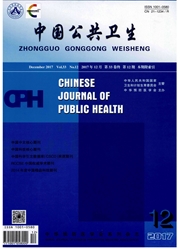

 中文摘要:
中文摘要:
目的 构建八维度健康信念模型,分析山东省农村居民周期性健康检查行为意向的影响因素,为提高居民健康检查参与率提供科学依据。方法 2014年3-9月,采用横断面调查方法分层随机抽取山东省胶南市、曲阜市和宁阳县农村居民共818人进行面对面问卷调查和定性访谈,测量人口学特征、周期性健康检查行为、健康信念模式各维度得分,并运用多元线性回归分析周期性健康检查行为意向的影响因素。结果 调查对象行为意向得分为(4.43±0.80)分,健康信念各维度得分分别为自我效能(21.45±2.89)分、健康知识(21.43±5.04)分、社会支持(49.07±9.70)分、感知易感性(21.64±3.87)分、感知严重性(10.61±4.98)分、感知益处(13.82±1.51)分、感知障碍(10.15±3.10)分、提示因素(20.96±5.08)分;多元线性回归分析显示,年收入低、健康知识水平低、自我效能低、感知到障碍多、感知到的益处少、感知易感性弱的农村居民周期性健康检查行为意向较差,其中感知障碍对行为意向的影响最大。结论 建议政府在医保资金上加大对临床预防服务的投入,同时以布告栏、乡村医生为媒介重点普及周期性健康检查知识,鼓励居民克服障碍,养成周期性健康检查的行为习惯。
 英文摘要:
英文摘要:
Objective To investigate the behavioral intention of periodic health examination and its main influencing factors among residents in rural areas of Shandong province by constructing an eight-dimension health belief model and to provide evidences for improving the use of periodic health examination in rural residents.Methods A total of 818 rural residents were selected to undertake a cross-sectional face-to-face questionnaire survey and qualitative interviews among rural residents in three areas of Shandong province.Demographic characteristics,behavioral intention of periodic health examination,and scores for the eight-dimension health belief model were measured.Multiple linear regression methods were adopted to identify the determinants of behavioral intention of periodic health examination.Results The average score of behavioral intention was 4.43±0.80,and scores for health belief based on the eight-dimension model were 21.45±2.89 for self-efficacy,21.43±5.04 for health knowledge,49.07±9.70 for social support,21.64±3.87 for perceived susceptibility,10.61±4.98 for perceived severity,13.82±1.51 for perceived benefits,10.15±3.10 for perceived barriers,and 20.96±5.08 for cues to action,respectively.Multivariate linear regression analysis showed that participants with lower family annual income,lower health knowledge,lower self-efficacy,more perceived barriers,less perceived benefits and perceived weaker susceptibility had poor behavioral intention of periodic health examination.Among them,perceived barriers was the most important determinant.Conclusion Governmental investment in clinical prevention services needs to be increased.Meanwhile,government agencies should focus on popularizing knowledge on periodic health examination to encourage rural residents overcoming the perceived barriers and developing the habit of periodic health examination.
 同期刊论文项目
同期刊论文项目
 同项目期刊论文
同项目期刊论文
 期刊信息
期刊信息
